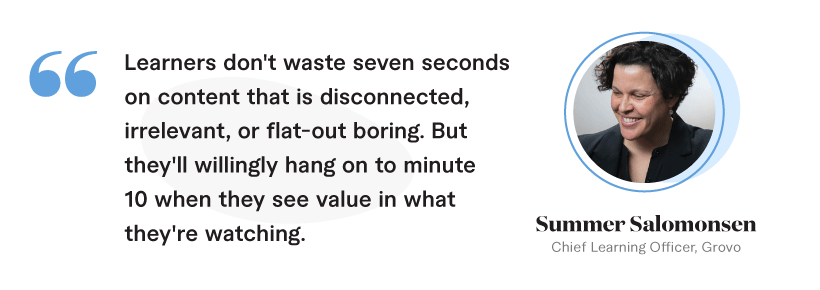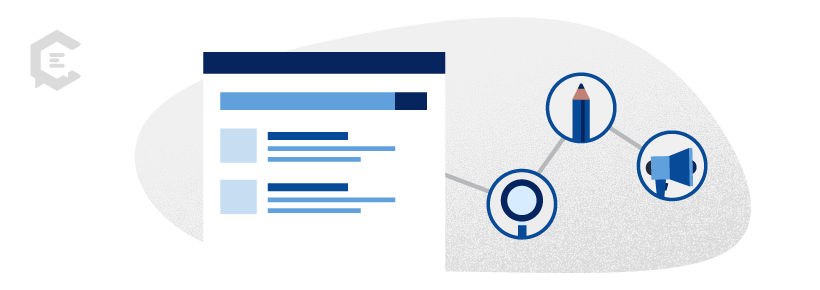Microlearning, or the portioning of learning units into relatively brief elements, is a buzzy word at the moment, and it’s stirring up a lot of feelings — hope, angst, confusion — in content strategy sessions throughout the marketing world.
But how do we face the immediate challenge of sifting through the glut of information and speculation to know if microlearning is right for your content strategy? Let’s think about roles.

As marketing professionals and business owners, we wear many hats throughout the workday. Some are more obvious than others, like the one listed on your business card or as the person who makes the best breakroom coffee. But believe it or not, your most important role is one that many of us think about the least.
If your business requires marketing or selling anything, even marketing the business itself, you are an educator. To achieve great product or service marketing, you must first be a great storyteller and, ultimately, a teacher, building with each piece of content — each interaction — a loyal customer support base.
After all, your company’s well-informed evangelists are often the best messengers for your brand. They know the ‘what,’ they’ve experienced the ‘how,’ and they believe in the ‘why’ that built your brand equity and got you to where you are today.
But this kind of support doesn’t come easy. In reality, the challenge of securing such indelible customers keeps growing as the possibilities for reaching eyes and ears, opening hearts and minds on the internet, in print, and over the airwaves ever expand. And at the same time, expectations have narrowed.
Why Microlearning is Important to Content Marketing
What would you say to a potential lead if you had less than five seconds to say it? A survey found that when web page speed was slower than web visitors expected, 45% of those surveyed were less likely to buy.
Thirty-seven percent were less likely to return to the site.
This is where the concept of a microlearning content strategy comes into play and perhaps why it has experienced such a meteoric rise over the years. Since 2012, use of the term has increased more than 1,300 percent, according to Google, with much of that rise taking place since 2016.
So, what is microlearning?
Even as microlearning experiences such a dramatic rise in interest, you might be surprised to find out how little consensus there is around what exactly we mean when discussing microlearning. It turns out there is a good reason for this disparity.
According to the SAGE Encyclopedia of Online Education, microlearning is the “segmentation of large amounts of information into small sections” for the purpose of education. By breaking primary subjects into consumable portions, microlearning enables students, or, in our case, a marketing audience, to build mastery or knowledge in an area by accumulation.
Common forms of microlearning include:
- Infographics
- Interactive learning guides
- Ebooks
- Interactive PDFs
- Animated instructional or informational videos
- Interactive videos
- Webinars
- Virtual reality/augmented reality (VR/AR) experiences
The list goes on. But beyond the basic elements, industry-specific definitions of microlearning remain elusive for at least two reasons — let’s tear the term apart. Learning, for all our familiarity with the word, is a varied practice. It refers to no single method or process; predictably, the same can be said about microlearning.
There is no one way to craft or deliver messages that are being micro-taught. And micro- is a prefix that is equally fraught. Micro- is, by its own definition, relative to whatever predefinitions we have established for the macro- or meso- (meaning “middle” or “intermediate”) elements that correspond to it. Micro- indicates no preset format and puts no pre-established temporal guardrails on the learning to which it refers.
Formal concepts like microlearning or microteaching have been with us for decades — at least since the 1960s — but have found their most symbiotic existence in the convenience and self-determined nature of online learning.
Microlearning Found a Happy Home on the Internet, and You Should, Too
Online education allows learners to progress at a pace that works harmoniously with busy schedules and nuanced lifestyles. So, it’s no wonder why or how microlearning finds its growing audience in online platforms, even when internet users’ UX/UI demands make inhospitable terrain for applying traditional Web 1.0 teaching methods.
People, as it turns out, are ruthless when consuming online content. All that clicking and swiping — to paraphrase a famous sports commentator, you can’t stop it; you can only hope to contain it. To do so, great content — content that grabs the reader, pulls at their stringy parts, and stokes engagement — has to tell a compelling story. And increasingly, as the statistics show, you have less and less time to tell that story.
But even if we didn’t have the luxury of statistics, we in the SEO-focused world of content marketing have seen the shift in our page rankings. Content that ranked consistently high went from long-form, keyword-stuffed pieces to short-form, back to long-form, down to 140 characters, up to 280.
Now you’re condensing your well-researched, experience-backed quarterly content strategy down to a TikTok of four lines of bold text laid over a video of your CEO dancing with their cat.
Content is King — But Only If It Has Value to Your Audience
No matter your format, the adage remains true: Content is king. Regardless of length, message, or medium, content designed to reach a target audience will be measured against a high-quality standard. Two primary considerations are how useful it is and how efficiently your content answers the questions people are asking. And more than ever, your message needs to meet its audience where they are — wherever that is — and at the speed to which they are accustomed.
As the Chief Learning Officer for New York-based technology company Grovo, Summer Salomonsen, said:

Is microlearning right for your content strategy? The short answer is yes. We’ve seen that short content can be successful in a marketing campaign, but there’s more to it than that.
Microlearning is (Probably) Right for Your Content Strategy
A content strategist would rarely suggest that a company push out only one type of content, written or otherwise. After all, diversifying your content is just as crucial to the success of a marketing campaign as diversifying revenue streams is to the sustainability of a business. But how do you know which types of content to produce for your specific audience and/or industry?
A good indicator of how best to wed content type to a given audience is through your search engine results pages (SERPs). SERPs refer to any result generated from a keyword search beyond traditional organic results and encompass all the types of content that most commonly appear as relevant search results for a given search term.
These include features like paid results, rich snippets, and knowledge cards but extend to:
- Top and bottom AdWords
- Shopping results
- Related questions
- Local packs
- Image packs
- Video results
From a strategy standpoint, your focus should be glued to the SERP results related to your content because they can be your canary in the coal mine telling you what content forms are ranking and how the consumer winds are shifting. And so, simply by analyzing your SERP results, it is possible to grasp whether or not microlearning content would improve your content strategy.
And because we are well into the 21st century, it’s reasonable to infer that microlearning content is not only right but essential, for your content strategy to remain ranking in the search results and people’s minds for some time.
Other ways to determine the usefulness of microlearning content to your overall strategy include:
-
- Content audit: Examine your existing content. It’s likely you’ve already employed some microlearning principles in your previous engagements. See how those pieces have performed and where you can make adjustments.
- Learner feedback and surveys: Collect feedback from your audience directly through polls, surveys, or questionnaires. Ask about their learning styles and interest in shorter, focused content, if they have any experience with microlearning content, and whether they found it helpful and applicable to their needs.
- Analytics tools: Check your website analytics tools and examine how users behave while on your site. Analyze data such as time spent on pages, interactions, and bounce rates to identify patterns and content preferences. Use heatmapping tools to visualize where users are clicking and engaging the most.
- Social media listening: Monitor social media for discussions around learning trends and preferences. Track any mentions for microlearning to gauge user sentiment.
- Sales funnel analysis: Sales funnels may vary from industry to industry, but they all serve the same function. Analyze your funnel to understand what types of content work best at which stage in the customer journey. You’ll likely find a use for microlearning along the way.
- Competitor analysis: Find out how your competitors or similar companies are using microlearning. Analyze their successes and challenges to understand whether this content strategy appeals to your shared audience.
- Pilot programs: If you haven’t yet employed any microlearning strategy, consider conducting a small-scale pilot program to test how your audience will respond. Based on participants’ feedback, refine your approach before scaling up.
- A/B testing: One of the best ways to know how your content will perform is to know. You can immediately put some of the microlearning principles listed above into action and crunch the data shortly after that to get a sense of what grabs attention, spurs engagement, and drives conversion.
Want Expert Content for Your Brand?
Whether short- or long-form, ClearVoice’s team of writers can craft expert content for your business. Talk to an expert content specialist today.







